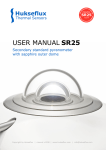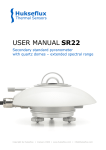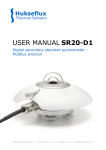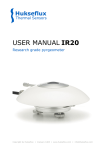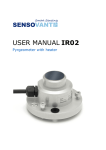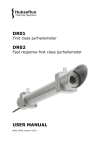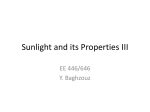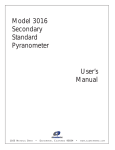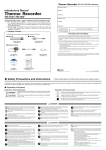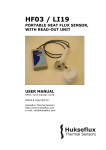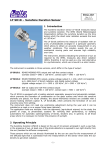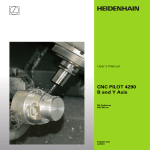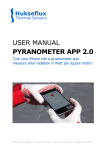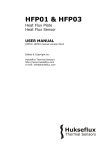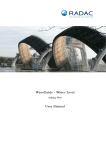Download USER MANUAL SR03 - Hukseflux - Thermal Sensors
Transcript
Hukseflux Thermal Sensors USER MANUAL SR03 Fast response second class pyranometer Copyright by Hukseflux | manual v1302 | www.hukseflux.com | [email protected] Warning statements Putting more than 12 Volt across the sensor wiring can lead to permanent damage to the sensor. Do not use “open circuit detection” when measuring the sensor output. sr03 manual v1302 2/45 Contents Warning statements Contents List of symbols Introduction Ordering and checking at delivery 1 Ordering SR03 1.1 Included items 1.2 Quick instrument check 1.3 Instrument principle and theory 2 Specifications of SR03 3 Specifications of SR03 3.1 Dimensions of SR03 3.2 Standards and recommended practices for use 4 Classification standard 4.1 General use for solar radiation measurement 4.2 General use for sunshine duration measurement 4.3 Specific use in meteorology and climatology 4.4 Installation of SR03 5 Site selection and installation 5.1 Installation of the optional sun screen 5.2 Electrical connection 5.3 Requirements for data acquisition / amplification 5.4 Making a dependable measurement 6 The concept of dependability 6.1 Reliability of the measurement 6.2 Speed of repair and maintenance / instrument lifetime 6.3 Uncertainty evaluation 6.4 Maintenance and trouble shooting 7 Recommended maintenance and quality assurance 7.1 Trouble shooting 7.2 Calibration and checks in the field 7.3 Data quality assurance 7.4 SR03-TR 8 Introduction SR03-TR 8.1 Dimensions of SR03-TR 8.2 Appendices 9 Appendix on cable extension / replacement 9.1 Appendix on tools for SR03 9.2 Appendix on spare parts for SR03 9.3 Appendix on standards for classification and calibration 9.4 Appendix on calibration hierarchy 9.5 Appendix on meteorological radiation quantities 9.6 Appendix on ISO and WMO classification tables 9.7 Appendix on definition of pyranometer specifications 9.8 Appendix on terminology / glossary 9.9 9.10 Appendix on conditions of sale: warranty and liability 9.11 EC declaration of conformity sr03 manual v1302 2 3 4 5 7 7 7 8 9 12 12 15 16 16 16 16 17 18 18 19 19 20 21 21 22 23 24 26 26 27 28 29 30 30 32 35 35 36 36 37 38 39 40 41 42 43 44 3/45 List of symbols Quantities Symbol Unit Voltage output Sensitivity Temperature Electrical resistance Solar irradiance Solar radiant exposure Time in hours U S T Re E H h V V/(W/m2) °C Ω W/m2 W∙h/m2 h (see also appendix 9.6 on meteorological quantities) Subscripts Not applicable sr03 manual v1302 4/45 Introduction SR03 is the fastest ISO 9060 second class compliant pyranometer available. Due to major advances in thermopile sensing technology, SR03 achieves a 95 % response time in just 1 second. SR03 is optimally suited for PV system performance monitoring, where long-term stability and synchronous response time between the PV module / array and pyranometer are required. SR03 is a solar radiation sensor that can be applied in general observations. It measures the solar radiation received by a plane surface from a field of view angle of 180o. This quantity, expressed in W/m2 , is called “hemispherical” solar radiation. Contrary to photodiode-based instruments, SR03 has a spectrally flat response across the full solar spectrum. SR03 pyranometer is used for general meteorological observations, building physics and solar collector testing. However, because of its fast response time, it is ideally suited for PV applications, where it will match the response time of the panels more closely than other pyranometer models. Use on ships and airplanes in conjunction with tilt sensors is also a possibility. In combination with the right software, also sunshine duration may be measured. Using SR03 is easy. It can be connected directly to commonly used datalogging systems. The irradiance in W/m2 is calculated by dividing the SR03 output, a small voltage, by the sensitivity. This sensitivity is provided with SR03 on its calibration certificate. The central equation governing SR03 is: E = U/S (Formula 0.1) The instrument should be used in accordance with the recommended practices of ISO, WMO and ASTM. Suggested use for SR03: • • PV system performance monitoring on buoys and on aircrafts Figure 0.1 SR03 fast response second class pyranometer sr03 manual v1302 5/45 Figure 0.2 SR03 fast response second class solar radiation sensor WMO has approved the “pyranometric method” to calculate sunshine duration from pyranometer measurements in WMO-No. 8, Guide to Meteorological Instruments and Methods of Observation. This implies that SR03 may be used, in combination with appropriate software, to estimate sunshine duration. This is much more cost-effective than using a dedicated sunshine duration sensor. Ask for our application note. Model SR03-TR houses a 4-20 mA transmitter for easy read-out by dataloggers commonly used in the industry. For more information see the chapter on SR03-TR. sr03 manual v1302 6/45 1 Ordering and checking at delivery 1.1 Ordering SR03 The standard configuration of SR03 is with 5 metres cable. Common options are: • • • Longer cable (in multiples of 5 m). Specify total cable length. SR03-TR first class pyranometer with 4-20 mA transmitter. Standard setting is 4 mA at 0 W/m2 and 20 mA at 1600 W/m2. Specify setting and total cable length. Sun screen. Specify order number SCR01. Supply of products is subject to Hukseflux’ General Conditions of Sale. The product warranty (involving repair or replacement without charge for product or working hours) is 24 months. Hukseflux does not accept any liability for losses or damages related to use of the supplied products. See the appendix and Hukseflux’ General Conditions of Sale for detailed statements on warranty and liability. 1.2 Included items Arriving at the customer, the delivery should include: • • • • pyranometer SR03 cable of the length as ordered product certificate matching the instrument serial number any other options as ordered Please store the certificate in a safe place. sr03 manual v1302 7/45 1.3 Quick instrument check A quick test of the instrument can be done by using a simple hand held multimeter and a lamp. 1. Check the electrical resistance of the sensor between the green (-) and white (+) wire. Use a multimeter at the 200 Ω range. Measure the sensor resistance first with one polarity, than reverse the polarity. Take the average value. The typical resistance of the wiring is 0.1 Ω/m. Typical resistance should be the typical sensor resistance of 100 to 200 Ω plus 1.5 Ω for the total resistance of two wires (back and forth) of each 5 m. Infinite resistance indicates a broken circuit; zero or a low resistance indicates a short circuit. 2. Check if the sensor reacts to light: put the multimeter at its most sensitive range of DC voltage measurement, typically the 100 x 10-3 VDC range or lower. Expose the sensor to a strong light source, for instance a 100 W light bulb at 0.1 m distance. The signal should read > 2 x 10-3 V now. Darken the sensor either by putting something over it or switching off the light. The instrument voltage output should go down and within one minute approach 0 V. 3. If applicable, remove the optional sun screen, using the hex key (see chapter on installation of the sun screen). Inspect the bubble level. 4. Inspect the instrument for any damage. sr03 manual v1302 8/45 2 Instrument principle and theory 3 4 5 2 1 8 7 6 Figure 2.1 Overview of SR03: (1) (2) (3) (4) (5) (6) (7) (8) cable, (standard length 5 metres, optional longer cable) cable gland thermal sensor with black coating glass dome sensor body levelling feet mounting hole bubble level sr03 manual v1302 9/45 SR03’s scientific name is pyranometer. A pyranometer measures the solar radiation received by a plane surface from a 180° field of view angle. This quantity, expressed in W/m2, is called “hemispherical” solar radiation. The solar radiation spectrum extends roughly from 285 to 3000 x 10-9 m. By definition a pyranometer should cover that spectral range with a spectral selectivity that is as “flat” as possible. In an irradiance measurement by definition the response to “beam” radiation varies with the cosine of the angle of incidence; i.e. it should have full response when the solar radiation hits the sensor perpendicularly (normal to the surface, sun at zenith, 0° angle of incidence), zero response when the sun is at the horizon (90° angle of incidence, 90° zenith angle), and 50 % of full response at 60° angle of incidence. A pyranometer should have a so-called “directional response” (older documents mention “cosine response”) that is as close as possible to the ideal cosine characteristic. In order to attain the proper directional and spectral characteristics, a pyranometer’s main components are: • a thermal sensor with black coating. It has a flat spectrum covering the 200 to 50000 x 10-9 m range, and has a near-perfect directional response. The coating absorbs all solar radiation and, at the moment of absorption, converts it to heat. The heat flows through the sensor to the sensor body. The thermopile sensor generates a voltage output signal that is proportional to the solar irradiance. • a glass dome. This dome limits the spectral range from 285 to 3000 x 10-9 m (cutting off the part above 3000 x 10-9 m), while preserving the 180° field of view angle. Another function of the dome is that it shields the thermopile sensor from the environment (convection, rain). • a second (inner) glass dome: For a first class pyranometer, two domes are used, and not one single dome. This construction provides an additional “radiation shield”, resulting in a better thermal equilibrium between the sensor and inner dome, compared to using a single dome. The effect of having a second dome is a strong reduction of instrument offsets. Pyranometers can be manufactured to different specifications and with different levels of verification and characterisation during production. The ISO 9060 - 1990 standard, “Solar energy - specification and classification of instruments for measuring hemispherical solar and direct solar radiation”, distinguishes between 3 classes; secondary standard (highest accuracy), first class (second highest accuracy) and second class (third highest accuracy). From second class to first class and from first class to secondary standard, the achievable accuracy improves by a factor 2. sr03 manual v1302 10/45 relative spectral content / response [arbitrary units] 1,2 1 solar radiation 0,8 pyranometer response 0,6 0,4 0,2 0 100 1000 10000 wavelength [x 10-9 m] Figure 2.2 Spectral response of the pyranometer compared to the solar spectrum. The pyranometer only cuts off a negligible part of the total solar spectrum. sr03 manual v1302 11/45 3 Specifications of SR03 3.1 Specifications of SR03 SR03 measures the solar radiation received by a plane surface from a from a 180o field of view angle. This quantity, expressed in W/m2, is called “hemispherical” solar radiation. Working completely passive, using a thermopile sensor, SR03 generates a small output voltage proportional to this flux. It can only be used in combination with a suitable measurement system. The instrument is classified according to ISO 9060 and should be used in accordance with the recommended practices of ISO, IEC, WMO and ASTM. Table 3.1.1 Specifications of SR03 (continued on next pages) SR03 SPECIFICATIONS REQUIRED BY ISO 9060* ISO classification (ISO 9060: 1990) WMO performance level (WMO-No-8, seventh edition 2008) Response time (95 %) Zero offset a (response to 200 W/m2 net thermal radiation) Zero offset b (response to 5 K/h change in ambient temperature) Non-stability Non-Linearity Directional response Spectral selectivity Temperature response Tilt response second class pyranometer moderate quality pyranometer 1s < ± 15 W/m2 unventilated < ± 4 W/m2 < < < < < < ± ± ± ± ± ± 1% change per year 1 % (100 to 1000 W/m2) 25 W/m2 5 % (0.35 to 1.5 x 10-6 m) 3 % (-10 to +40 °C) 2 % (0 to 90 ° at 1000 W/m2) *For the exact definition of pyranometer ISO 9060 specifications see the appendix. sr03 manual v1302 12/45 Table 3.1.1 Specifications of SR03 (continued) SR03 ADDITIONAL SPECIFICATIONS Measurand Measurand in SI radiometry units Optional measurand Field of view angle Measurement range Sensitivity range Sensitivity (nominal) Expected voltage output Measurement function / required programming Measurement function / optional programming for sunshine duration Required readout Optional readout Rated operating temperature range Sensor resistance range Required sensor power Spectral range (20 % transmission points) Standard governing use of the instrument Standard cable length (see options) Cable diameter Cable gland: cable diameter range Cable replacement Mounting Levelling Levelling accuracy IP protection class Gross weight including 5 m cable Net weight including 5 m cable Packaging sr03 manual v1302 hemispherical solar radiation irradiance in W/m2 sunshine duration 180 ° 0 to 2000 W/m-2 7 to 25 x 10-6 V/(W/m2) 15 x 10-6 V/(W/m2) application under natural solar radiation: -0.1 to + 50 x 10-6 V E = U/S programming according to WMO guide paragraph 8.2.2 1 differential voltage channel or 1 single ended voltage channel, input resistance > 106 Ω 1 temperature channel in case optional temperature sensor is ordered -40 to +80 °C 100 to 200 Ω zero (passive sensor) 285 to 3000 x 10-9 m ISO/TR 9901:1990 Solar energy -- Field pyranometers -- Recommended practice for use ASTM G183 - 05 Standard Practice for Field Use of Pyranometers, Pyrheliometers and UV Radiometers 5m 4 x 10-3 m accepts cable diameters from 4 to 6 x 10-3 m cable can be removed and installed by the user provided that the cable is sealed at the sensor side against humidity ingress. Consult Hukseflux for instructions or use Hukseflux-supplied parts 2 x M5 bolt at 65 mm centre-to-centre distance on north-south axis bubble level and adjustable levelling feet are included < 0.4 ° bubble entirely in ring IP 67 0.5 kg 0.3 kg box of (170 x 90 x 230) x 10-3 m 13/45 Table 3.1.1 Specifications of SR03 (started on previous pages) CALIBRATION Calibration traceability Calibration hierarchy Calibration method Calibration uncertainty Recommended recalibration interval Reference conditions Validity of calibration MEASUREMENT ACCURACY Uncertainty of the measurement Achievable uncertainty (95% confidence level) daily totals Achievable uncertainty (95% confidence level) hourly totals VERSIONS / OPTIONS to WRR from WRR through ISO 9846 and ISO 9847, applying a correction to reference conditions indoor calibration according to ISO 9847, Type IIc < 1.8 % (k = 2) 2 years 20 °C, normal incidence solar radiation, horizontal mounting, irradiance level 1000 W/m2 based on experience the instrument sensitivity will not change during storage. During use under exposure to solar radiation the instrument “non-stability” specification is applicable. statements about the overall measurement uncertainty can only be made on an individual basis. See the chapter on uncertainty evaluation ± 10 % (reference: WMO-No.-8 , seventh edition 2008) ± 20 % (reference: WMO-No.-8 , seventh edition 2008) 4-20 mA transmitter creating a 4-20 mA output signal, option code = TR, with adapted housing standard setting is 4 x 10-6 A at 0 W/m2 and 20 x 10-6 A at 1600 W/m2 for specifications see the chapter on SR03-TR Longer cable, in multiples of 5 m ACCESSORIES option code = total cable length Sun screen for use on SR03 Separate amplifiers Hand-held read-out unit SCR01 AC100 and AC420 LI19 sr03 manual v1302 14/45 3.2 Dimensions of SR03 Figure 3.2.1 Dimensions of SR03 in 10-3 m. sr03 manual v1302 15/45 4 Standards and recommended practices for use Pyranometers are classified according to the ISO 9060 standard and the WMO-No. 8 Guide. In any application the instrument should be used in accordance with the recommended practices of ISO, IEC, WMO and / or ASTM. 4.1 Classification standard Table 4.1.1 Standards for pyranometer classification. See the appendix for definitions of pyranometer specifications, and a table listing the specification limits. STANDARDS FOR INSTRUMENT CLASSIFICATION ISO STANDARD EQUIVALENT ASTM STANDARD WMO ISO 9060:1990 Solar energy -- specification and classification of instruments for measuring hemispherical solar and direct solar radiation Not available WMO-No. 8; Guide to Meteorological Instruments and Methods of Observation, chapter 7, measurement of radiation, 7.3 measurement of global and diffuse solar radiation 4.2 General use for solar radiation measurement Table 4.2.1 Standards with recommendations for instrument use in solar radiation measurement STANDARDS FOR INSTRUMENT USE FOR HEMISPHERICAL SOLAR RADIATION ISO STANDARD EQUIVALENT ASTM STANDARD WMO ISO/TR 9901:1990 Solar energy -- Field pyranometers -- Recommended practice for use ASTM G183 - 05 Standard Practice for Field Use of Pyranometers, Pyrheliometers and UV Radiometers WMO-No. 8; Guide to Meteorological Instruments and Methods of Observation, chapter 7, measurement of radiation, 7.3 measurement of global and diffuse solar radiation 4.3 General use for sunshine duration measurement According to the World Meteorological Organization (WMO, 2003), sunshine duration during a given period is defined as the sum of that sub-period for which the direct solar irradiance exceeds 120 W/m2. sr03 manual v1302 16/45 WMO has approved the “pyranometric method” to estimate sunshine duration from pyranometer measurements (Chapter 8 of the WMO Guide to Instruments and Observation, 2008). This implies that a pyranometer may be used, in combination with appropriate software, to estimate sunshine duration. Ask for our application note. Table 4.3.1 Standards with recommendations for instrument use in sunshine duration measurement STANDARDS FOR INSTRUMENT USE FOR SUNSHINE DURATION WMO WMO-No. 8; Guide to Meteorological Instruments and Methods of Observation, chapter 8, measurement of sunshine duration, 8.2.2 Pyranometric Method 4.4 Specific use in meteorology and climatology The World Meteorological Organization (WMO) is a specialised agency of the United Nations. It is the UN system's authoritative voice on the state and behaviour of the earth's atmosphere and climate. WMO publishes WMO-No. 8; Guide to Meteorological Instruments and Methods of Observation, in which a table is included on “level of performance” of pyranometers. Nowadays WMO conforms itself to the ISO classification system. sr03 manual v1302 17/45 5 Installation of SR03 5.1 Site selection and installation Table 5.1.1 Recommendations for installation of pyranometers Location The situation that shadows are cast on the instruments is usually not desirable. The horizon should be as free from obstacles as possible. Ideally there should be no objects between the course of the sun and the instrument. Mechanical mounting / thermal insulation preferably use connection by bolts to the bottom plate of the instrument. A pyranometer is sensitive to thermal shocks. Do not mount the instrument with the body in direct thermal contact to the mounting plate (so always use the levelling feet also if the mounting is not horizontal), do not mount the instrument on objects that become very hot (black coated metal plates). Instrument mounting with 2 bolts 2 x M5 bolt at 65 x 10-3 m centre to centre distance on north-south axis, connection through the pyranometer flange. Instrument mounting with one bolt not applicable Performing a representative measurement the pyranometer measures the solar radiation in the plane of the sensor. This may require installation in a tilted or inverted position. The black sensor surface (sensor bottom plate) should be mounted parallel to the plane of interest. In case a pyranometer is not mounted horizontally or in case the horizon is obstructed, the representativeness of the location becomes an important element of the measurement. See the chapter on uncertainty evaluation. Levelling in case of horizontal mounting only use the bubble level and levelling feet. The optional sun screen must be removed for inspection of the bubble level. Instrument orientation by convention with the cable exit pointing to the nearest pole (so the cable exit should point north in the northern hemisphere, south in the southern hemisphere). Installation height in case of inverted installation, WMO recommends a distance of 1.5 m between soil surface and sensor (reducing the effect of shadows and in order to obtain good spatial averaging). sr03 manual v1302 18/45 5.2 Installation of the optional sun screen The optional SCR01 sun screen can be installed and removed using a hex key (size 2 x 10-6 m). See the drawing below. 1 2 3 Figure 5.2.1 Installation and removal of sun screen: Turn the set screw using the hex key and lift of the sun screen. (1) hex key, (2) sun screen, (3) set screw 5.3 Electrical connection In order to operate, a pyranometer should be connected to a measurement system, typically a so-called datalogger. SR03 is a passive sensor that does not need any power. Cables generally act as a source of distortion, by picking up capacitive noise. We recommend keeping the distance between a datalogger or amplifier and the sensor as short as possible. For cable extension, see the appendix on this subject. Table 5.3.1 The electrical connection of SR03 WIRE COLOUR MEASUREMENT SYSTEM Sensor output + White Voltage input + Sensor output - Green Voltage input - or ground Shield Bare metal Analogue ground Figure 5.3.1 Electrical diagram of SR03. The shield is connected to the sensor body. sr03 manual v1302 19/45 Table 5.3.2 Standard internal connection of SR03 at the internal printed circuit board SENSOR PRINTED CIRCUIT COLOUR CODE WIRE Plus (+) + White Minus (-) - Green Shield SH Bare metal TR Not connected unless the sensor has a trimmed sensitivity or limited sensitivity range 5.4 Requirements for data acquisition / amplification The selection and programming of dataloggers is the responsibility of the user. Please contact the supplier of the data acquisition and amplification equipment to see if directions for use with the SR03 are available. In case programming for similar instruments is available, this can typically also be used. SR03 can usually be treated in the same way as other thermopile pyranometers. Pyranometers usually have the same programming as heat flux sensors. In case of the SR03-TR version, the output is 4 to 20 x 10-3 A. See the chapter on the SR03-TR. Table 5.4.1 Requirements for data acquisition and amplification equipment for SR03 in the standard configuration Capability to measure small voltage signals preferably: 5 x 10-6 V uncertainty Minimum requirement: 20 x 10-6 V uncertainty (valid for the entire expected temperature range of the acquisition / amplification equipment) Capability for the data logger or the software to store data, and to perform division by the sensitivity to calculate the solar irradiance. E = U/S (Formula 0.1) Data acquisition input resistance > 1 x 106 Ω Open circuit detection (WARNING) open-circuit detection should not be used, unless this is done separately from the normal measurement by more than 5 times the sensor response time and with a small current only. Thermopile sensors are sensitive to the current that is used during open circuit detection. The current will generate heat, which is measured and will appear as an offset. sr03 manual v1302 20/45 6 Making a dependable measurement 6.1 The concept of dependability A measurement with a pyranometer is called “dependable” if it is reliable, i.e. measuring within required uncertainty limits, for most of the time and if problems, once they occur, can be solved quickly. The requirements for a measurement with a pyranometer may be expressed by the user as: • • • required uncertainty of the measurement (see following paragraphs) requirements for maintenance and repairs (possibilities for maintenance and repair including effort to be made and processing time) a requirement to the expected instrument lifetime (until it is no longer feasible to repair) It is important to realise that the uncertainty of the measurement is not only determined by the instrument but also by the way it is used. See also ISO 9060 note 5. In case of pyranometers, the measurement uncertainty as obtained during outdoor measurements is a function of: • • • • • • the instrument class the calibration procedure / uncertainty the duration of instrument employment under natural sunlight (involving the instrument stability specification) the measurement conditions (such as tilting, ventilation, shading, instrument temperature) maintenance (mainly fouling) the environmental conditions* Therefore, ISO 9060 says, “statements about the overall measurement uncertainty under outdoor conditions can only be made on an individual basis, taking all these factors into account”. * defined at Hukseflux as all factors outside the instrument that are relevant to the measurement such as the cloud cover (presence or absence of direct radiation), sun position, the local horizon (which may be obstructed) or condition of the ground (when tilted). The environmental conditions also involve the question whether or not the measurement at the location of measurement is representative of the quantity that should be measured. sr03 manual v1302 21/45 6.2 Reliability of the measurement A measurement is reliable if it measures within required uncertainty limits for most of the time. We distinguish between two causes of unreliability of the measurement: • • related to the reliability of the pyranometer and its design, manufacturing, calibration (hardware reliability). related to the reliability of the measurement uncertainty (measurement reliability), which involves hardware reliability as well as condition of use. Most of the hardware reliability is the responsibility of the instrument manufacturer. The reliability of the measurement however is a joint responsibility of instrument manufacturer and user. As a function of user requirements, taking into account measurement conditions and environmental conditions, the user will select an instrument of a certain class, and define maintenance support procedures. In many situations there is a limit to a realistically attainable accuracy level. This is due to conditions that are beyond control once the measurement system is in place. Typical limiting conditions are: • • • the measurement conditions, for instance when working at extreme temperatures when the instrument temperature is at the extreme limits of the rated temperature range. the environmental conditions, for instance when installed at a sub-optimal measurement location with obstacles in the path of the sun. the environmental conditions, for instance when assessing PV system performance and the system contains panels at different tilt angles, the pyranometer measurement may not be representative of irradiance received by the entire PV system. The measurement reliability can be improved by maintenance support. Important aspects are: • • • dome fouling by deposition of dust, dew, rain or snow. Fouling results in undefined measurement uncertainty (sensitivity and directional error are no longer defined). This should be solved by regular inspection and cleaning. sensor instability. Maximum expected sensor aging is specified per instrument as its non-stability in [% change / year]. In case the sensor is not recalibrated, the uncertainty of the sensitivity gradually will increase. This is solved by regular recalibration. moisture condensing under pyranometer domes resulting in a slow change of sensitivity (within specifications). This is solved by regular replacement of desiccant or by maintenance (drying the entire sensor) in case the sensor allows this. For nonserviceable sensors like Hukseflux second class pyranometers (for example model SR03), this may slowly develop into a defect. For first class and secondary standard models (for instance model SR20 secondary standard pyranometer) extra desiccant (in a set of 5 bags in an air tight bag) is available. sr03 manual v1302 22/45 Another way to improve measurement reliability is to introduce redundant sensors. • • The use of redundant instruments allows remote checks of one instrument using the other as a reference, which leads to a higher measurement reliability. In PV system performance monitoring, in addition to instruments measuring in the plane of array, horizontally placed instruments are used for the measurement of global radiation. Global irradiance data enable the user to compare the local climate and system efficiency between different sites. These data can also be compared to measurements by local meteorological stations. 6.3 Speed of repair and maintenance / instrument lifetime Dependability is not only a matter of reliability but also involves the reaction to problems; if the processing time of service and repairs is short, this contributes to the dependability. Hukseflux pyranometers are designed to allow easy maintenance and repair. The main maintenance actions are: • • replacement of desiccant (not applicable for SR03) replacement of cabling For optimisation of dependability a user should: • • • estimate the expected lifetime of the instrument design a schedule of regular maintenance design a schedule of repair or replacement in case of defects When operating multiple instruments in a network Hukseflux recommends keeping procedures simple and having a few spare instruments to act as replacements during service, recalibrations and repair. Hukseflux pyranometers are designed to be suitable for the intended use for at least 5 years under normal meteorological conditions. Factory warranty (granting free of charge repair) for defects that are clearly traceable to errors in production is 2 years. The “product expected lifetime” is defined as the minimum number of years of employment with normal level of maintenance support, until the instrument is no longer suitable for its intended use (cannot be repaired). For pyranometers, the product expected lifetime depends heavily on the environmental conditions. Examples of environments with reduced expected lifetime are areas with high levels of air pollution and areas with high levels of salt in the air. Both cause enhanced corrosion. It is not possible to give a generally applicable statement about expected lifetime. In Hukseflux’ experience it is not realistic to expect a lifetime longer than 10 years except in very dry environments such as very dry tropical or polar climates. sr03 manual v1302 23/45 Examples: Hukseflux model LP02 second class pyranometer has been produced since 2004. In 2012, the number of instruments in the field is estimated to be above 4000. Hukseflux quality management’s interpretation of service records is that the Mean Time Between Failure (MTBF) of LP02 is larger than 6 years (only defects and large repairs are counted as failures). SR03 fast response second class pyranometer is based on similar technology. 6.4 Uncertainty evaluation The uncertainty of a measurement under outdoor or indoor conditions depends on many factors, see paragraph 1 of this chapter. It is not possible to give one figure for pyranometer measurement uncertainty. The work on uncertainty evaluation is “in progress”. There are several groups around the world participating in standardisation of the method of calculation. The effort aims to work according to the guidelines for uncertainty evaluation (according to the “Guide to Expression of Uncertainty in Measurement” or GUM). 6.4.1 Evaluation of measurement uncertainty under outdoor conditions Hukseflux actively participates in the discussions about pyranometer measurement uncertainty; we also provide spreadsheets, reflecting the latest state of the art, to assist our users in making their own evaluation. The input to the assessment is summarised: 1) The formal evaluation of uncertainty should be performed in accordance with ISO 98-3 Guide to the Expression of Uncertainty in Measurement, GUM. 2) The specifications of the instrument according to the list of ISO 9060 classification of pyranometers and pyrheliometers are entered as limiting values of possible errors, to be analysed as type B evaluation of standard uncertainty per paragraph 4.3.7. of GUM. A priori distributions are chosen as rectangular. 3) A separate estimate has to be entered to allow for estimated uncertainty due to the instrument maintenance level. 4) The calibration uncertainty has to be entered. Please note that Hukseflux calibration uncertainties are lower than those of alternative equipment. These uncertainties are entered in measurement equation (equation is usually Formula 0.1: E = U/S), either as an uncertainty in E (zero offsets, directional response) in U (voltage readout errors) or in S (tilt error, temperature dependence, calibration uncertainty). 5) In uncertainty analysis for pyranometers, the location and date of interest is entered. The course of the sun is then calculated, and the direct and diffuse components are estimated, based on a model; the angle of incidence of direct radiation is a major factor in the uncertainty. 6) In uncertainty analysis for modern pyrheliometers: tilt dependence often is so low that one single typical observation may be sufficient. 7) In case of special measurement conditions, typical specification values are chosen. These should for instance account for the measurement conditions (shaded / unshaded, ventilated/ unventilated, horizontal / tilted) and environmental conditions (clear sky / cloudy, working temperature range). sr03 manual v1302 24/45 8) Among the various sources of uncertainty, some are “correlated”; i.e. present during the entire measurement process, and not cancelling or converging to zero when averaged over time; the off-diagonal elements of the covariance matrix are not zero. Paragraph 5.2 of GUM. 9) Among the various sources of uncertainty, some are “uncorrelated”; cancelling or converging to zero when averaged over time; the off-diagonal elements of the covariance matrix are zero. Paragraph 5.1 of GUM. 10) Among the various sources of uncertainty, some are “not included in analysis”; this applies for instance to non-linearity for pyranometers, because it is already included in the directional error, and the spectral response for pyranometers and pyrheliometers because it is already taken into account in the calibration process. Table 6.4.1.1 Preliminary estimates of achievable uncertainties of measurements with pyranometers. The estimates are based on typical pyranometer properties and calibration uncertainty, for sunny, clear sky days and well maintained stations, without uncertainty loss due to lack of maintenance and due to instrument fouling. The table specifies expanded uncertainties with a coverage factor of 2 and confidence level of 95 %. Estimates are based on 1 s sampling. IMPORTANT NOTE: there is no international consensus on uncertainty evaluation of pyranometer measurements, so this table should not be used as a formal reference. Pyranometer class (ISO 9060) season latitude uncertainty minute totals at solar noon uncertainty hourly totals at solar noon uncertainty daily totals secondary standard summer mid-latitude 2.7 % 2.0 % 1.9 % equator pole 2.6 % 7.9 % 1.9 % 5.6 % 1.7 % 4.5 % winter mid-latitude 3.4 % 2.5 % 2.7 % summer mid-latitude 4.7 % 3.3 % 3.4 % equator 4.4 % 3.1 % 2.9 % pole 16.1% 11.4 % 9.2 % winter mid-latitude 6.5 % 4.5 % 5.2 % summer mid-latitude 8.4 % 5.9 % 6.2 % equator 7.8 % 5.5 % 5.3 % pole 29.5 % 21.6 % 18.0 % mid-latitude 11.4 % 8.1 % 9.9 % first class second class (SR03) winter 6.4.2 Calibration uncertainty From 2011 to 2012, calibration of SR03 has been improved. New procedures were developed in close cooperation with PMOD World Radiation Center in Davos, Switzerland. Our latest calibration method results in an uncertainty of the sensitivity of less than 1.8 %, compared to typical uncertainties of higher than 3.5 % for this pyranometer class. See the appendix for detailed information on calibration hierarchy. sr03 manual v1302 25/45 7 Maintenance and trouble shooting 7.1 Recommended maintenance and quality assurance SR03 can measure reliably at a low level of maintenance in most locations. Usually unreliable measurements will be detected as unreasonably large or small measured values. As a general rule this means that regular visual inspection combined with a critical review of the measured data, preferably checking against other measurements, is the preferred way to obtain a reliable measurement. Table 7.1.1 Recommended maintenance of SR03. If possible the data analysis and cleaning (1 and 2) should be done on a daily basis. MINIMUM RECOMMENDED PYRANOMETER MAINTENANCE INTERVAL SUBJECT ACTION 1 1 week data analysis compare measured data to maximum possible / maximum expected irradiance and to other measurements nearby (redundant instruments). Also historical seasonal records can be used as a source for expected values. Analyse night time signals. These signals may be negative (down to -5 W/m2 on clear windless nights), due to zero offset a. In case of use with PV systems, compare daytime measurements to PV system output. Look for any patterns and events that deviate from what is normal or expected. 2 2 weeks cleaning use a soft cloth to clean the dome of the instrument, persistent stains can be treated with soapy water or alcohol 3 6 months inspection inspect cable quality, inspect cable glands, inspect mounting position, inspect cable, clean instrument, clean cable, inspect levelling, change instrument tilt in case this is out of specification, inspect mounting connection, inspect interior of dome for condensation. desiccant replacement desiccant replacement (not applicable for SR03) recalibration recalibration by side-by-side comparison to a higher standard instrument in the field according to ISO 9847. lifetime assessment judge if the instrument should be reliable for another 2 years, or if it should be replaced parts replacement if applicable / necessary replace the parts that are most exposed to weathering; cable, cable gland, sun screen. NOTE: use Hukseflux approved parts only. 8 internal inspection if applicable: open instrument and inspect / replace O-rings; dry internal cavity around the circuit board 9 recalibration recalibration by side-by-side comparison to a higher standard instrument indoors according to ISO 9847 or outdoors according to ISO9846 4 5 2 years 6 7 6 years sr03 manual v1302 26/45 7.2 Trouble shooting Table 7.2.1 Trouble shooting for SR03 The sensor does not give any signal Check the electrical resistance of the sensor between the green (-) and white (+) wire. Use a multimeter at the 200 Ω range. Measure the sensor resistance first with one polarity, than reverse the polarity. Take the average value. The typical resistance of the wiring is 0.1 Ω/m. Typical resistance should be the typical sensor resistance of 100 to 200 Ω plus 1.5 Ω for the total resistance of two wires (back and forth) of each 5 m. Infinite resistance indicates a broken circuit; zero or a low resistance indicates a short circuit. Check if the sensor reacts to light: put the multimeter at its most sensitive range of DC voltage measurement, typically the 100 x 10-3 VDC range or lower. Expose the sensor to strong light source, for instance a 100 W light bulb at 1 x 10-1 m distance. The signal should read > 2 x 10-3 V now. Darken the sensor either by putting something over it or switching off the light. The instrument voltage output should go down and within one minute approach 0 V. Check the data acquisition by applying a 1 x 10-6 V source to it in the 1 x 10-6 V range. The sensor signal is unrealistically high or low. Note that night-time signals may be negative (down to -5 W/m2 on clear windless nights), due to zero offset a. Check if the pyranometer has clean domes. Check the location of the pyranometer; are there any obstructions that could explain the measurement result. Check the orientation / levelling of the pyranometer. Check if the right calibration factor is entered into the algorithm. Please note that each sensor has its own individual calibration factor, as documented in its calibration certificate. Check if the voltage reading is divided by the calibration factor in review of the algorithm. Check the condition of the wiring at the logger. Check the cable condition looking for cable breaks. Check the range of the data logger; signal can be negative (this could be out of range) or the amplitude could be out of range. Check the data acquisition by applying a 1 x 10-6 V source to it in the 1 x 10-6 V range. Look at the output. Check if the output is as expected. Check the data acquisition by short circuiting the data acquisition input with a 100 Ω resistor. Look at the output. Check if the output is close to 0 W/m2. The sensor signal shows unexpected variations Check etc.) Check Check Check the presence of strong sources of electromagnetic radiation (radar, radio the condition of the shielding. the condition of the sensor cable. if the cable is not moving during the measurement The dome Arrange to send the sensor back to Hukseflux for diagnosis. shows internal condensation. sr03 manual v1302 27/45 7.3 Calibration and checks in the field Recalibration of field pyranometers is typically done by comparison in the field to a reference pyranometer. The applicable standard is ISO 9847 “International StandardSolar Energy- calibration of field pyranometers by comparison to a reference pyranometer”. At Hukseflux an indoor calibration according to the same standard is used. Hukseflux recommendation for re-calibration: if possible, perform calibration indoor by comparison to an identical reference instrument, under normal incidence conditions. In case of field comparison; ISO recommends field calibration to a higher class pyranometer. Hukseflux suggests also allowing use of sensors of the same model and class, because intercomparisons of similar instruments has the advantage that they suffer from the same offsets. It is therefore just as good to compare to pyranometers of the same brand and type as to compare to an instrument of a higher class. ISO recommends to perform field calibration during several days; 2 to 3 days under cloudless conditions, 10 days under cloudy conditions. In general this is not achievable. In order to shorten the calibration process Hukseflux suggests to allow calibration at normal incidence, using hourly totals near solar noon. Hukseflux main recommendations for field intercomparisons are: 1) to take normal incidence as a reference and not the entire day. 2) to take a reference of the same brand and type as the field pyranometer or a pyranometer of a higher class, and 3) to connect both to the same electronics, so that electronics errors (also offsets) are eliminated. 4) to mount all instruments on the same platform, so that they have the same body temperature. 5) assuming that the electronics are independently calibrated, to analyse radiation values at normal incidence radiation (possibly tilting the radiometers to approximately normal incidence); if this is not possible to compare 1 hour totals around solar noon for horizontally mounted instruments. 6) for second class radiometers, to correct deviations of more than ± 10 %. Lower deviations should be interpreted as acceptable and should not lead to a revised sensitivity. 7) for first class pyranometers, to correct deviations of more than ± 5 %. Lower deviations should be interpreted as acceptable and should not lead to a revised sensitivity. 8) for secondary standard instruments, to correct deviations of more than ± 3 %. Lower deviations should be interpreted as acceptable and should not lead to a revised sensitivity. sr03 manual v1302 28/45 7.4 Data quality assurance Quality assurance can be done by: • • • • analysing trends in solar irradiance signal plotting the measured irradiance against mathematically generated expected values comparing irradiance measurements between sites analysis of night time signals The main idea is that one should look out for any unrealistic values. There are programs on the market that can semi-automatically perform data screening: See http://www.dqms.com sr03 manual v1302 29/45 8 SR03-TR 8.1 Introduction SR03-TR As a special version of SR03, Hukseflux offers model SR03-TR: a fast response second class pyranometer with 4-20 mA transmitter. SR03-TR is a second class solar radiation sensor that is applied in most common solar radiation observations. SR03-TR pyranometer is used for general meteorological observations, building physics and solar collector testing. However, because of its fast response time, it is ideally suited for PV applications, where it will match the response time of the panels more closely than other pyranometer models. SR03-TR houses a 4-20 mA transmitter for easy read-out by dataloggers commonly used in the industry. Using SR03-TR is easy. The pyranometer can be connected directly to commonly used data logging systems. The irradiance in W/m2 is calculated by using the transmitter’s output. In LP02-TR’s standard configuration, the 4 to 20 mA output corresponds to a transmitted range of 0 to 1600 W/m2. This range can be adjusted at the factory upon request. Figure 8.1.1 SR03-TR fast response second class pyranometer with 4-20 mA transmitter sr03 manual v1302 30/45 Table 8.1.1 Specifications of SR03-TR SR03-TR SPECIFICATIONS Description Transmitted range Output signal Principle Supply voltage Options fast response second class pyranometer with 4-20 mA transmitter 0 to 1600 W/m2 4 to 20 x 10-3 A 2-wire current loop 7.2 to 35 VDC adapted transmitted range longer cable, in multiples of 5 m For definition of pyranometer ISO 9060 specifications see the appendix. Table 8.1.2 Requirements for data acquisition and amplification equipment with the SR03–TR configuration Capability to - measure 4-20 mA or - measure currents or - measure voltages sr03 manual v1302 The SR03-TR has a 4-20 mA output. There are several possibilities to handle this signal. It is important to realise that the signal wires not only act to transmit the signal but also act as power supply. Some dataloggers have a 4-20 mA input. In that case the connection can be directly made. Some dataloggers have the capability to measure currents. In some cases the datalogger accepts a voltage input. Usually a 100 Ω precision resistor is used to convert the current to a voltage (this will then be in the 0.4 – to 2 VDC range). This resistor must be put in the + wire of the sensor. In the two latter cases the user must check that the low side of the input channel is connected to ground, and the high side to a positive voltage in the required range. 31/45 8.2 Dimensions of SR03-TR 3 2 4 5 1 8 7 6 Figure 8.2.1 Overview of SR03-TR: (1) (2) (3) (4) (5) (6) (7) (8) cable, (standard length 5 metres, optional longer cable) cable gland thermal sensor with black coating glass dome sensor body transmitter housing levelling feet bubble level sr03 manual v1302 32/45 Figure 8.2.2 Dimensions of SR03-TR in 10-3 m sr03 manual v1302 33/45 sr03 manual v1302 34/45 9 Appendices 9.1 Appendix on cable extension / replacement The sensor cable can be removed and installed by the user provided that the cable is sealed at the sensor side against humidity ingress. Please consult Hukseflux for instructions on cable preparation or use Hukseflux-supplied parts. SR03 is equipped with one cable. Keep the distance between data logger or amplifier and sensor as short as possible. Cables act as a source of distortion by picking up capacitive noise. In an electrically “quiet” environment the SR03 cable can however be extended without problem to 100 meters. If done properly, the sensor signal, although small, will not significantly degrade because the sensor resistance is very low (so good immunity to external sources) and because there is no current flowing (so no resistive losses). Cable and connection specifications are summarised below. NOTE: the body of SR03 contains connector blocks that can be used for the internal connection of a new cable. See the chapter on electrical connections. Usually it is easier to connect a new extended cable inside the pyranometer body cable than to make a good (weatherproof) connection to an existing cable. Table 9.1.1 Preferred specifications for cable extension of SR03 General please consult Hukseflux for instructions or use Hukseflux-supplied parts. Cable 2-wire, shielded, with copper conductor (at Hukseflux 3-wire shielded cable is used, of which only 2 wires are used) Sealing sealed at the sensor side against humidity ingress Core resistance < 0.1 Ω/m Outer diameter ± 4 to 6 x 10-3 m (to fit cable gland) Length cables should be kept as short as possible, in any case the total cable length should be less than 100 m Outer sheet with specifications for outdoor use (for good stability in outdoor applications) Connection either solder the new cable core and shield to the original sensor cable, and make a waterproof connection using cable shrink, or use gold plated waterproof connectors. Always connect shield. sr03 manual v1302 35/45 9.2 Appendix on tools for SR03 Table 9.2.1 Specifications of tools for SR03 tooling required for sun screen fixation and removal hex key 2 x 10-3 m tooling required for cable gland fixation and removal spanner size 15 x 10-3 m tooling required for wire fixation and removal (internal wiring inside SR03 body) screwdriver blade width 2 x 10-3 m 9.3 • • • • Appendix on spare parts for SR03 Levelling feet (set of 3) SR03 cable (specify length in multiples of 5 m), sealed at one end Cable gland SR03 O-ring SR03 sr03 manual v1302 36/45 9.4 Appendix on standards for classification and calibration Both ISO and ASTM have standards on instrument classification and methods of calibration. The World Meteorological Organisation (WMO) has largely adopted the ISO classification system. Table 9.4.1 Pyranometer standardisation in ISO and ASTM. STANDARDS ON INSTRUMENT CLASSIFICATION AND CALIBRATION ISO STANDARD EQUIVALENT ASTM STANDARD ISO 9060:1990 Solar energy -- Specification and classification of instruments for measuring hemispherical solar and direct solar radiation not available Comment: work is in progress on a new ASTM equivalent standard Comment: a standard “Solar energy --Methods for testing pyranometer and pyrheliometer characteristics” has been announced in ISO 9060 but is not yet implemented. not available ISO 9846:1993 Solar energy -- Calibration of a pyranometer using a pyrheliometer ASTM G167 - 05 Standard Test Method for Calibration of a Pyranometer Using a Pyrheliometer ISO 9847:1992 Solar energy -- Calibration of field pyranometers by comparison to a reference pyranometer ASTM E 824 -10 Standard Test Method for Transfer of Calibration from Reference to Field Radiometers ASTM G207 - 11 Standard Test Method for Indoor Transfer of Calibration from Reference to Field Pyranometers ISO 9059:1990 Solar energy -- Calibration of field pyrheliometers by comparison to a reference pyrheliometer sr03 manual v1302 ASTM E 816 Standard Test Method for Calibration of Pyrheliometers by Comparison to Reference Pyrheliometers 37/45 9.5 Appendix on calibration hierarchy The World Radiometric Reference (WRR) is the measurement standard representing the SI unit of irradiance. It was introduced in order to ensure world-wide homogeneity of solar radiation measurements and is in use since 1980. The WRR was determined from the weighted mean of the measurements of a group of 15 absolute cavity radiometers which were fully characterised. It has an estimated accuracy of 0.3%. The WMO introduced its mandatory use in its status in 1979. The world-wide homogeneity of the meteorological radiation measurements is guaranteed by the World Radiation Center in Davos Switzerland, by maintaining the World Standard Group (WSG) which materialises the World Radiometric Reference. See http://www.pmodwrc.ch The Hukseflux standard is traceable to an outdoor WRR calibration. Some small corrections are made to transfer this calibration to the Hukseflux standard conditions: sun at zenith and 1000 W/m2 irradiance level. During the outdoor calibration the sun is typically at 20 to 40 ° zenith angle, and the total irradiance at a 700 W/m2 level. Table 9.5.1 Calibration hierarchy for pyranometers WORKING STANDARD CALIBRATION AT PMOD / WRC DAVOS Calibration of working standard pyranometers: Method: ISO 9846, type 1 outdoor. This working standard has an uncertainty “uncertainty of standard”. The working standard has been calibrated under certain “test conditions of the standard”. The working standard has traceability to WRR world radiometric reference. CORRECTION OF (WORKING) STANDARD CALIBRATION TO STANDARDISED REFERENCE CONDITIONS Correction from “test conditions of the standard” to “reference conditions” i.e. to normal incidence and 20 °C: Using known (working) standard pyranometer properties: directional, non linearity, offsets, temperature dependence). This correction has an uncertainty; “uncertainty of correction”. At Hukseflux we also call the working standard pyranometer “standard”. INDOOR PRODUCT CALIBRATION Calibration of products, i.e. pyranometers: Method: according to ISO 9847, Type IIc, which is an indoor calibration. This calibration has an uncertainty associated with the method. (In some cases like the BSRN network the product calibration is with a different method; for example again type 1 outdoor) CALIBRATION UNCERTAINTY CALCULATION ISO 98-3 Guide to the Expression of Uncertainty in Measurement, GUM Determination of combined expanded uncertainty of calibration of the product, including uncertainty of the working standard, uncertainty of correction, uncertainty of the method (transfer error). The coverage factor must be determined; at Hukseflux we work with a coverage factor k = 2. sr03 manual v1302 38/45 9.6 Appendix on meteorological radiation quantities A pyranometer measures irradiance. The time integrated total is called radiant exposure. In solar energy radiant exposure is often given in W∙h/m 2. Table 9.6.1 Meteorological radiation quantities as recommended by WMO (additional symbols by Hukseflux Thermal Sensor). POA stands for Plane of Array irradiance. The term originates from ASTM and IEC standards. SYMBOL DESCRIPTION CALCULATION UNITS E↓ downward irradiance E↓ = E g ↓ + E l ↓ W/m2 H↓ downward radiant exposure for a specified time interval H↓ = H g ↓ + H l ↓ J/m2 E↑ upward irradiance E↓ = E g ↓ + E l ↓ W/m2 H↑ upward radiant exposure for a specified time interval H↓ = H g ↓ + H l ↓ J/m2 W∙h/m2 Change of units E direct solar irradiance normal to the apparent solar zenith angle solar constant W/m2 DNI Direct Normal Irradiance E0 Eg ↓ h Eg ↓ t Ed ↓ global irradiance; hemispherical irradiance on a specified, in this case horizontal surface.* global irradiance; hemispherical irradiance on a specified, in this case tilted surface.* downward diffuse solar radiation W/m2 E g ↓ = E cos θ h + Ed↓ W/m2 GHI Global Horizontal Irradiance E g ↓ = E∙cos θ t + E d ↓ t + E r ↑ t *** W/m2 POA Plane of Array W/m2 DHI Diffuse Horizontal Irradiance E l ↑, E l ↓ upward / downward longwave irradiance W/m2 Er↑ reflected solar irradiance W/m2 E* net irradiance T↓ apparent surface temperature** apparent sky temperature** sunshine duration T↑ SD ALTERNATIVE EXPRESSION E* = E↓ – E↑ W/m2 ºC or K ºC or K h θ is the apparent solar zenith angle θ h relative to horizontal, θ t relative to a tilted surface g = global, l = long wave, t = tilted *, h = horizontal* * distinction horizontal and tilted from Hukseflux, ** T symbols introduced by Hukseflux, *** contributions of E d ↓ t and E r ↑ t are E d ↓ and E r ↑ both corrected for the tilt angle of the surface sr03 manual v1302 39/45 9.7 Appendix on ISO and WMO classification tables Table 9.7.1 Classification table for pyranometers per ISO 9060 and WMO. NOTE: WMO specification of spectral selectivity is different from that of ISO. Hukseflux conforms to the ISO limits. WMO also specifies expected accuracies. ISO finds this not to be a part of the classification system because it also involves calibration. Please note that WMO expected accuracies are for clear days at mid latitudes and that the uncertainty estimate does not include uncertainty due to calibration*. ISO CLASSIFICATION** TABLE ISO CLASS SECONDARY STANDARD FIRST CLASS SECOND CLASS 15 s + 7 W/m2 30 s + 15 W/m2 60 s + 30 W/m2 ± 2 W/m2 ± 4 W/m2 ± 8 W/m2 ± 0.8 % ± 0.5 % ± 10 W/m2 ± 1.5 % ±1% ± 20 W/m2 ±3% ±3% ± 30 W/m2 Spectral selectivity (350 to 1 500 x 10-9 m) (WMO 300 to 3 000 x 10-9 m) ±3% ±5% ± 10 % Temperature response (interval of 50 K)** 2% 4% 8% Tilt response (0 to 90 ° at 1000 W/m2) ± 0.5 % ±2% ±5% WMO CLASS HIGH QUALITY GOOD QUALITY WMO: expected accuracy for daily sums* 2% 5% MODERATE QUALITY 10 % WMO: expected accuracy for hourly sums* 3% 8% 20 % 1 W/m2 5 W/m2 10 W/m2 individual instrument only: all specs must comply group compliance group compliance Specification limit Response time (95 %) Zero offset a (response to 200 W/m2 net thermal radiation) Zero offset b (response to 5 K/h in ambient temperature) Non stability (change per year) Non linearity (100 to 1000 W/m2) Directional response ADDITIONAL WMO SPECIFICATIONS WMO: expected accuracy for minute sums* WMO: resolution (smallest detectable change) CONFORMITY TESTING*** ISO 9060 * WMO 7.2.1: The estimated uncertainties are based on the following assumptions: (a) instruments are well-maintained, correctly aligned and clean; (b) 1 min and 1 h figures are for clear-sky irradiances at solar noon; (c) daily exposure values are for clear days at mid-latitudes. WMO 7.3.2.5: Table 7.5 lists the expected maximum deviation from the true value, excluding calibration errors. ** At Hukseflux we use the expression ± 1 % instead of a range of 2 %. *** an instrument is subject to conformity testing of its specifications. Depending on the classification, conformity compliance can be proven either by group- or individual compliance. A specification is fulfilled if the mean value of the respective test result does not exceed the corresponding limiting value of the specification for the specific category of instrument. sr03 manual v1302 40/45 9.8 Appendix on definition of pyranometer specifications Table 9.8.1 Definition of pyranometer specifications SPECIFICATION DEFINITION SOURCE Response time (95 %) time for 95 % response. The time interval between the instant when a stimulus is subjected to a specified abrupt change and the instant when the response reaches and remains within specified limits around its final steady value.The response time is a measure of the thermal inertia inherent in the stabilization period for a final reading. response to 200 W/m2 net thermal radiation (ventilated). Hukseflux assumes that unventilated instruments have to specify the zero-offset in unventilated – worst case – conditions. Zero offsets are a measure of the stability of the zero-point. Zero offset a is visible at night as a negative offset, the instrument dome irradiates in the far infra red to the relatively cold sky. This causes the dome to cool down. The pyranometer sensor irradiates to the relatively cool dome, causing a negative offset. Zero offset a is also assumed to be present during daytime. response to 5 K/h change in ambient temperature. Zero offsets are a measure of the stability of the zero-point. ISO 90601990 WMO 1.6.3 Zero offset a: (200 W/m2 net thermal radiation ) Zero offset b: (5 K/h in ambient temperature) Non stability (change per year) Non linearity (100 to 1000 W/m2) Directional response Spectral selectivity (350 to 1500 x 10-9 m) (WMO 300 to 3000 x 10-9 m) Temperature response (interval of 50 K) Tilt response (0° to 90° at 1000 W/m2) Sensitivity Spectral range percentage change in sensitivity per year. The dependence of sensitivity resulting from ageing effects which is a measure of the long-term stability. percentage deviation from the sensitivity at 500 W/m2 due to the change in irradiance within the range of 100 W/m2 to 1000 W/m2. Non-linearity has an overlap with directional response, and therefore should be handled with care in uncertainty evaluation. the range of errors caused by assuming that the normal incidence sensitivity is valid for all directions when measuring from any direction a beam radiation whose normal incidence irradiance is 1000 W/m2 . Directional response is a measure of the deviations from the ideal “cosine behaviour” and its azimuthal variation. percentage deviation of the product of spectral absorptance and spectral transmittance from the corresponding mean within 350 x 10-9 m to 1500 x 10-9 m and the spectral distribution of irradiance. Spectral selectivity is a measure of the spectral selectivity of the sensitivity. percentage deviation of the sensitivity due to change in ambient temperature within an interval of 50 K the temperature of the pyranometer body. percentage deviation from the sensitivity at 0° tilt (horizontal) due to change in tilt from 0° to 90° at 1000 W/m2 irradiance. Tilt response describes changes of the sensitivity due to changes of the tilt angle of the receiving surface. the change in the response of a measuring instrument divided by the corresponding change in the stimulus. the spectral range of radiation to which the instrument is sensitive. For a normal pyranometer this should be in the 0.3 to 3 x 10-6 m range. Some pyranometers with coloured glass domes have a limited spectral range. sr03 manual v1302 ISO 90601990 ISO 90601990 ISO 90601990 ISO 90601990 ISO 90601990 ISO 90601990 ISO 90601990 ISO 90601990 WMO 1.6.3 Hukseflux 41/45 9.9 Appendix on terminology / glossary Table 9.9.1 Definitions and references of used terms TERM DEFINITION (REFERENCE) Solar energy or solar radiation solar energy is the electromagnetic energy emitted by the sun. Solar energy is also called solar radiation and shortwave radiation. The solar radiation incident on the top of the terrestrial atmosphere is called extra-terrestrial solar radiation; 97 % of which is confined to the spectral range of 290 to 3 000 x 10-9 m. Part of the extra-terrestrial solar radiation penetrates the atmosphere and directly reaches the earth’s surface, while part of it is scattered and / or absorbed by the gas molecules, aerosol particles, cloud droplets and cloud crystals in the atmosphere. The former is the direct component, the latter is the diffuse component of the solar radiation. (ref: WMO, Hukseflux) solar radiation received by a plane surface from a 180 ° field of view angle (solid angle of 2 π sr).(ref: ISO 9060) the solar radiation received from a 180 ° field of view angle on a horizontal surface is referred to as global radiation. Also called GHI. This includes radiation received directly from the solid angle of the sun’s disc, as well as diffuse sky radiation that has been scattered in traversing the atmosphere. (ref: WMO) Hemispherical solar radiation received by a horizontal plane surface. (ref: ISO 9060) also POA: hemispherical solar irradiance in the plane of a PV array. (ref: ASTM E2848-11 / IEC 61724) Hemispherical solar radiation Global solar radiation Plane-of-array irradiance Direct solar radiation Terrestrial or Longwave radiation World Radiometric Reference (WRR) Albedo Angle of incidence Zenith angle radiation received from a small solid angle centred on the sun’s disc, on a given plane. (ref: ISO 9060) radiation not of solar origin but of terrestrial and atmospheric origin and having longer wavelengths (3 000 to 100 000 x 10-9 m). In case of downwelling E l ↓ also the background radiation from the universe is involved, passing through the ”atmospheric window”. In case of upwelling E l ↑, composed of long-wave electromagnetic energy emitted by the earth’s surface and by the gases, aerosols and clouds of the atmosphere; it is also partly absorbed within the atmosphere. For a temperature of 300 K, 99.99 % of the power of the terrestrial radiation has a wavelength longer than 3 000 x 10-9 m and about 99 per cent longer than 5 000 x 10-9 m. For lower temperatures, the spectrum shifts to longer wavelengths. (ref: WMO) measurement standard representing the Sl unit of irradiance with an uncertainty of less than ± 0.3 % (see the WMO Guide to Meteorological Instruments and Methods of Observation, 1983, subclause 9.1.3). The reference was adopted by the World Meteorological Organization (WMO) and has been in effect since 1 July 1980. (ref: ISO 9060) ratio of reflected and incoming solar radiation. Dimensionless number that varies between 0 and 1. Typical albedo values are: < 0.1 for water, from 0.1 for wet soils to 0.5 for dry sand, from 0.1 to 0.4 for vegetation, up to 0.9 for fresh snow. angle of radiation relative to the sensor measured from normal incidence (varies from 0° to 90°). Azimuth angle angle of incidence of radiation, relative to zenith. Equals angle of incidence for horizontally mounted instruments angle of incidence of radiation, projected in the plane of the sensor surface. Varies from 0° to 360°. 0 is by definition the cable exit direction, also called north, west is + 90°. Sunshine duration sunshine duration during a given period is defined as the sum of that sub-period for which the direct solar irradiance exceeds 120 W/m2. (ref: WMO) sr03 manual v1302 42/45 9.10 Appendix on conditions of sale: warranty and liability Delivery of goods is subject to Hukseflux General Conditions of Sale. Hukseflux has the following warranty and liability policy: Hukseflux guarantees the supplied goods to be new, free from defects related to bad performance of materials and free from faults that are clearly related to production and manufacturing. Warranty on products is valid until 24 months after transfer of ownership. The warranty does not apply if the application involves significant “wear and tear”, if it involves use outside the specified range of application, or if it involves accidental damage or misuse. The warranty expires when anyone other than Hukseflux makes modifications to or repairs the products. Hukseflux is in no event liable for damages, to its customers or anyone claiming through these customers, associated to the goods or services it supplies. sr03 manual v1302 43/45 9.11 EC declaration of conformity We, Hukseflux Thermal Sensors B.V. Elektronicaweg 25 2628 XG Delft The Netherlands in accordance with the requirements of the following directive: 2004/108/EC The Electromagnetic Compatibility Directive hereby declare under our sole responsibility that: Product model: Type: SR03 Pyranometer has been designed to comply and is in conformity with the relevant sections and applicable requirements of the following standards: Emission: Immunity: Emission: Emission: EN EN EN EN 61326-1 (2006) 61326-1 (2006) 61000-3-2 (2006) 61000-3-3 (1995) + A1 (2001) + A2 (2005). Kees VAN DEN BOS Director Delft December 12, 2011 sr03 manual v1302 44/45 © 2013, Hukseflux Thermal Sensors B.V. www.hukseflux.com Hukseflux Thermal Sensors B.V. reserves the right to change specifications without notice.













































